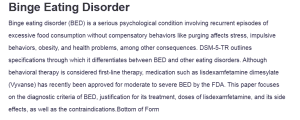Binge Eating Disorder
Binge eating disorder (BED) is a serious psychological condition involving recurrent episodes of excessive food consumption without compensatory behaviors like purging affects stress, impulsive behaviors, obesity, and health problems, among other consequences. DSM-5-TR outlines specifications through which it differentiates between BED and other eating disorders. Although behavioral therapy is considered first-line therapy, medication such as lisdexamfetamine dimesylate (Vyvanse) has recently been approved for moderate to severe BED by the FDA. This paper focuses on the diagnostic criteria of BED, justification for its treatment, doses of lisdexamfetamine, and its side effects, as well as the contraindications.Bottom of Form
Diagnostic Criteria for Binge Eating Disorder
DSM-5-TR criteria for diagnosing binge eating disorder (BED) are binges occurring weekly for three months, with the binges being fast eating of large quantities of food and feeling a lack of control, and at least three of the following five characteristic behaviors being necessary
- Eating until feeling uncomfortably full.
- Consuming large amounts of food when not physically hungry.
- Eating alone due to embarrassment about food intake.
- Feeling disgusted, guilty, or depressed after binge episodes (American Psychiatric Association, 2022).
To be classified as BED, these behaviors must cause significant distress and occur without compensatory actions like purging. BED differs from bulimia and anorexia and increases risks for obesity, diabetes, hypertension, and cardiovascular disease, requiring early diagnosis and intervention (Psychiatric Association 2024).
Lisdexamfetamine Dimesylate for Binge Eating Disorder
Lisdexamfetamine dimesylate (Vyvanse) serves as the sole medication approved by the FDA to treat BED. Lisdexamfetamine dimesylate originated for ADHD treatment, but medical studies show it effectively treats BED by adjusting norepinephrine and dopamine levels in the body. Through its mechanism of action, Lisdexamfetamine dimesylate enables patients to regulate their impulsive eating behaviors along with decreasing binge eating events.
Dosage and Titration
The standard starting dose for lisdexamfetamine in BED treatment is 30 mg once daily, taken in the morning. If necessary, the dosage can be increased in increments of 20 mg at weekly intervals, based on patient response and tolerance. The maximum daily dose is 70 mg (De la Torre & Albericio, 2024). Patients must be closely monitored for side effects and therapeutic responses during dosage adjustments.
Common Side Effects of Lisdexamfetamine Dimesylate
Lisdexamfetamine is therapeutic for binge eating disorder but is also linked with side effects such as suppression of appetite, weight loss, insomnia, and restlessness, which can result in malnutrition. It can also lead to heart rate and blood pressure changes, xerostomia, gastrointestinal disturbance, and mood changes such as anxiety or irritability. These side effects can be avoided or reduced by vigilant monitoring and titration of doses, especially in individuals with cardiac complications.
Contraindications of Lisdexamfetamine Dimesylate
Lisdexamfetamine has unfavorable interactions with some medical conditions, such as cardiovascular disease in the form of arrhythmias or high blood pressure, because it raises cardiac output and blood pressure. It can also exacerbate hyperthyroidism or glaucoma. It is not safe to take lisdexamfetamine with monoamine oxidase inhibitors within 14 days of use, and individuals with bipolar disorder or schizophrenia need to be monitored closely for possible worsening of mood instability or psychosis.
The Rationale for Using Lisdexamfetamine Dimesylate in BED
The mechanism of lisdexamfetamine focuses on the neurological underpinnings of BED through activity against brain pathways to compulsive food bingeing. It decreases hunger, curbs the urge to eat, and modulates impulse control so that patients no longer binge on food. It increases satiety and executive function in order to choose better food. All these actions make it a useful drug to control serious BED symptoms, but vigilant use with close monitoring and adequate patient selection are indicated due to its side effect profile as a stimulant medication.
Conclusion
Binge eating disorder fulfills all the criteria necessary to be considered a severe eating disorder with life-threatening complications. The DSM-5-TR outlines its criteria and differentiates it from other related disorders. However, therapy is the first and foremost approach, while lisdexamfetamine dimesylate can suppress the number of binge episodes through neurotransmitter regulation. This is why monitoring is critical, and an approach that covers therapy, medicine administration, and diet is vital if the condition is to be well managed.
References
American Psychiatric Association. (2022). Diagnostic and statistical manual of mental disorders: DSM-5-TR / American Psychiatric Association (5th ed.). American Psychiatric Association Publishing.
De la Torre, B. G., & Albericio, F. (2024). The pharmaceutical industry in 2023: An analysis of FDA drug approvals from the perspective of molecules. Molecules, 29(3), 585. https://doi.org/10.3390/molecules29030585
ORDER A PLAGIARISM-FREE PAPER HERE
We’ll write everything from scratch
Question 
List the diagnostic criteria for binge eating disorder.
Lisdexamfetamine dimesylate is FDA-approved for binge eating disorder. List the daily dosage, common side effects, contraindications, and rationale for use.
Criteria
Diagnostic criteria for binge eating disorder
List all the diagnostic criteria from DSM-5
lisdexamfetamine dimesylate
List dosing information for lisdexamfetamine dimesylate Starting dose Titration schedule Max dose for binge eating disorder

Binge Eating Disorder
Common side effects
List most common side effects of lisdexamfetamine dimesylate. What would you warn your patient about and what would they expect to experience on this medication.
Rational
What is the rational for using lisdexamfetamine dimesylate in this patient population.
Text:
- DSM-5-TR text